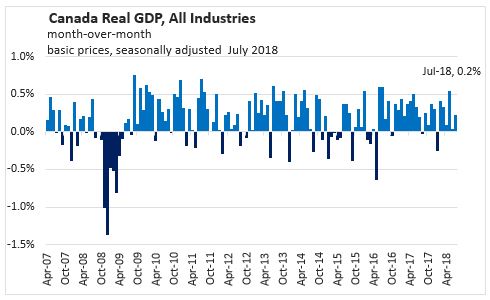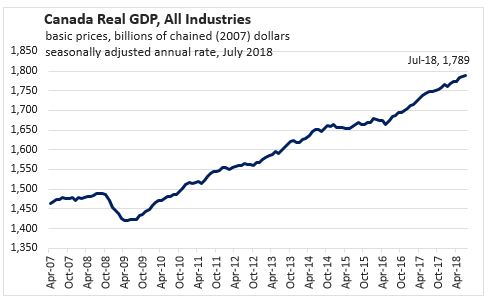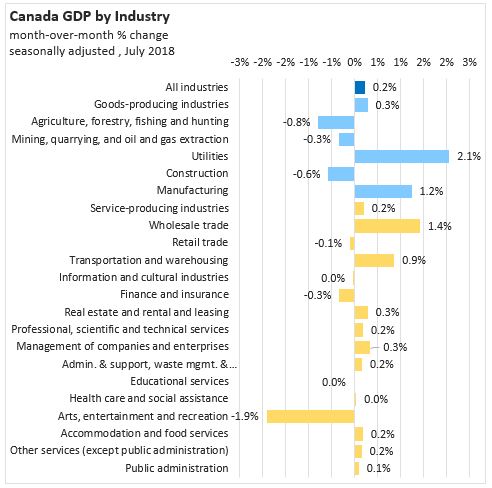The Economics and Statistics Division maintains archives of previous publications for accountability purposes, but makes no updates to keep these documents current with the latest data revisions from Statistics Canada. As a result, information in older documents may not be accurate. Please exercise caution when referring to older documents. For the latest information and historical data, please contact the individual listed to the right.
<--- Return to Archive
For additional information relating to this article, please contact:
September 28, 2018CANADA GDP BY INDUSTRY, JULY 2018 Real GDP in Canada grew 0.2 per cent in July 2018 compared to June, after remaining essentially unchanged in June. Growth occurred in 12 of 20 sectors led by manufacturing, wholesale trade, utilities and transportation and warehousing. Compared to July 2017, the Canadian economy is 2.4 per cent larger with an annualized value of $1,789 billion (chained 2007 dollars).


The output of the goods-producing industries increased 0.3 per cent in July. Manufacturing grew 1.2 per cent with its strongest showing since November 2017. Non-durable manufacturing was up 2.4 per cent with its highest growth in four years on rising chemical shipments and a petroleum and coal product manufacturing increase following earlier maintenance shutdowns. Durable manufacturing rose 0.3 per cent and in 7 of 10 subsectors including wood products, fabricated metal and machinery manufacturing. construction output declined for third time in past four months on lower residential construction in new structures and home alterations and improvements. Non-residential construction contracted 0.5 per cent on lower public and commercial construction while engineering and other construction was up 0.2 per cent. Mining, quarrying, and oil and gas extraction was down 0.3 per cent in July after growth earlier in the year. The oil and gas subsector was down in part due to maintenance work while mining was up 3.8 per cent on resumed iron ore production and higher output at diamond and potash mines. The utilities sector grew with record-breaking heat in parts of the country.
Service-producing industries output edged up 0.2 per cent in July. Wholesale activity recovered from June's decline with growth in 8 of 9 subsectors while retail trade was down 0.1 per cent on lower activity at motor vehicle dealers and general merchandise stores. Higher activity of manufacturing and wholesale activity led to growth in transportation activities including rail, truck, and support activities. Real estate activity continues to recover with a 1.0 per cent gain in July following a 13.5 per cent contraction in Q1 2018. The public sector was essentially unchanged with growth in health and public administration offsetting a decline in education sector.

GDP was 2.7 per cent higher in January-July 2018 than in the same period last year. Year-to-date growth was 3.7 per cent in the goods-producing sector, with the subsectors of Mining, quarrying, and oil and gas extraction (5.5%), Utilities (2.1%), Construction(4.7%), and Manufacturing(2.4), reporting positive growth. Agriculture, forestry, fishing and hunting (-0.2%) is reporting a decline for the first seven months of the year. Services are up 2.3 per cent compared to January-July 2017, with the strongest growth in wholesale (+4.7%), professional, scientific and technical services (+4.1%), arts, entertainment and recreation (+3.7%), transportation and warehousing (+3.4%) and health care and social assistance (+3.3%).

Statistics Canada. Table 36-10-0434-01 Gross domestic product (GDP) at basic prices, by industry, monthly (x 1,000,000)
<--- Return to Archive